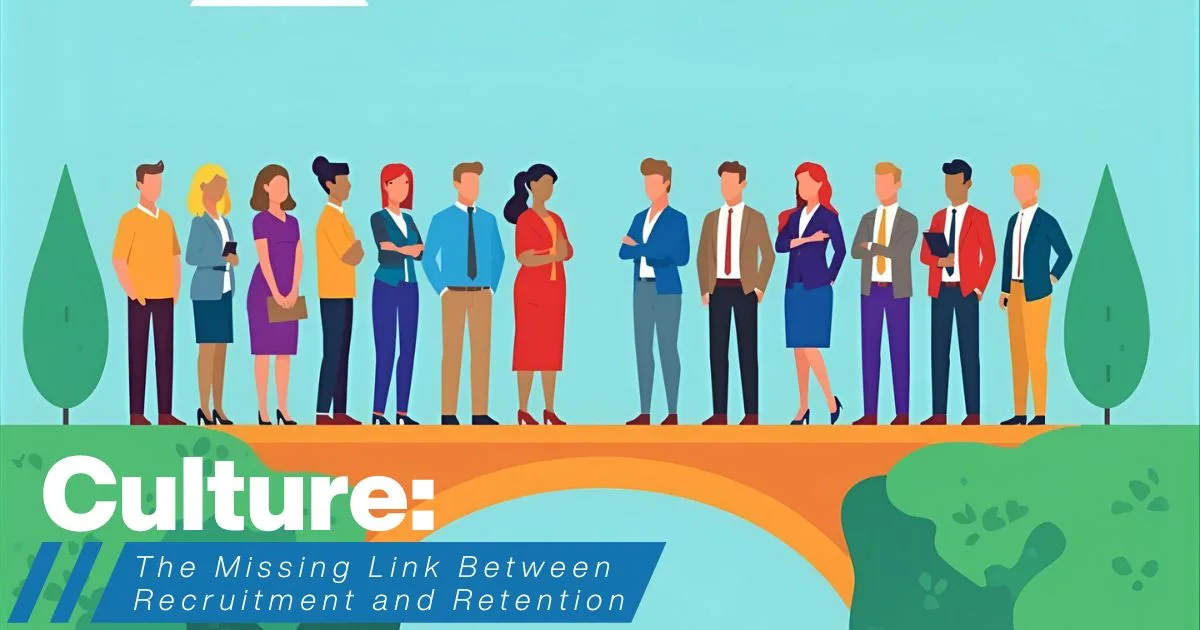Why Culture Matters More Than Ever in Recruitment and Retention
Most leaders focus on strategy, benefits, or technology when they talk about hiring and keeping talent. But here is the truth: your firm has a culture whether you built it intentionally or not. And that culture is either fueling your growth or quietly sabotaging it.
The numbers make it clear:
- 70% of employees are disengaged at work.
- Firms with weak culture experience up to 50% higher turnover and 18% lower productivity.
- Only 28% of employees say their personal values align with the company they work for.
Recruitment can get people through the door. Retention keeps them in the room. But culture is the invisible thread that ties both together.
The Cost of Culture Drift in a Hybrid and AI-Driven World
Hybrid Work and the Culture Challenge
Hybrid work is not just a policy shift. It is a cultural shift. Stanford research shows employees who work from home two days a week are just as productive and promotable as office-only peers, yet their retention rates are significantly higher. Eagle Hill Consulting found that remote and hybrid employees often report a more positive outlook on organizational culture compared to those in the office every day.
But here is the catch. That positive outlook exists only when leaders intentionally design connection and belonging into their systems. Without that design, culture begins to drift.
Look at Nationwide and Edward Jones. Both organizations leaned heavily into their values to guide hybrid work policies. They launched internal campaigns like We Are the Culture that reinforced connection, empathy, and inclusion, even when teams were no longer sitting in the same physical space. That is culture by design, not culture by default.
AI’s Double-Edged Sword in the Workplace
Artificial intelligence is rewriting how work gets done. A Stanford study showed a 13 percent decline in entry-level job postings in coding and customer service. That signals a real challenge for mentorship and on-the-job learning, because many professionals once started in those roles before moving up.
I explored this further in AI in the Workplace: Power Tool or Junior Employee? where I unpack how AI is reshaping early career roles and what that means for the future pipeline of leaders.
At the same time, AI is boosting productivity and creating opportunities for personalization in employee engagement. The problem is not the technology itself. The problem is whether leaders set cultural guardrails that keep AI human-centered.
Without those guardrails, firms risk losing mentorship, trust, and belonging. With them, AI can amplify recruitment and retention by freeing people to focus on work that matters, while creating room for innovation and growth.
The Ten Cultural Elements That Drive Health and Retention
A healthy culture is not abstract. It can be measured. In the Culture Impact Scorecard, ten elements consistently reveal whether a firm is thriving or struggling.
- Effective Communication – Clear, consistent information that reduces confusion and builds trust.
- Trust and Respect – Confidence in leaders and peers, backed by integrity and fairness.
- Teamwork and Collaboration – Departments and individuals aligning around shared goals.
- Empowerment and Accountability – Freedom to act, paired with responsibility for results.
- Continuous Learning and Development – Ongoing investment in skills, mentoring, and growth.
- Living Our Values – Core values actively modeled and reinforced in decisions and behavior.
- Celebration and Appreciation – Recognition that is consistent, timely, and meaningful.
- Seen and Heard – Belonging, inclusion, and psychological safety where voices matter.
- Fun and Positive Environment – Energy, motivation, and positivity that sustain morale.
- Support and Care – Genuine empathy and help during challenges, both professional and personal.
These are not just ideals. They are observable and measurable. And when leaders track them consistently, they get a true picture of cultural health.
Spotlight on Core Elements
Effective Communication
Most firms do not have a communication problem. They have a clarity problem. Teams are hearing the words, but interpreting them differently. Managers assume understanding when alignment never happened. Meetings often end long, unclear, and unresolved.
Measurement shows where clarity is strong, where it is breaking down, and what needs fixing.
Empowerment and Accountability
Firms want results, but many avoid holding people accountable for how those results are achieved. The best people then carry more than their share, or they disengage. On the other side of the spectrum, when empowerment is withheld, people feel micromanaged or stuck waiting for permission.
The healthiest firms measure both sides, empowerment and accountability, to find the balance that creates ownership without chaos.
Living Our Values
Values written on the wall are marketing. Values in meetings, hiring, and promotions are culture. There is a big difference between aspirational values and lived values.
By measuring “Living Our Values,” firms surface whether decisions actually reflect their stated beliefs or if employees see them as just words.
Culture as a Strategic Lever for Recruitment and Retention
Recruiters sell the story of why someone should join. HR leaders fight the battle of why someone should stay. Both win or lose based on culture.
- A strong culture acts as a talent magnet, attracting candidates who align with values.
- A strong culture is also a retention engine, keeping people engaged long after onboarding.
- A weak culture creates bias, drives turnover, and damages employer brand.
Recruitment is no longer about filling seats. It is about building firms people never want to leave.
Reflection Questions for Leaders and Recruiters
To make this real, consider these questions:
- Which of the ten cultural elements would your team score the lowest if measured today?
- What is one recent miscommunication that cost your team time, energy, or trust?
- Where is your culture drifting instead of being designed?
- If AI or hybrid work is reshaping your firm, what cultural guardrails are you putting in place to keep the human element alive?
For more on this idea, see AI in the Workplace: Power Tool or Junior Employee?
These are not just discussion points. They are diagnostic questions every recruiter and HR leader should ask today.
Final Word: Measure What Matters
You do not drift into a great firm. You build one.
Recruitment and retention are not separate conversations. They are two sides of the same coin, and culture is the edge that connects them.
That is why measurement matters. The ten elements of a healthy culture can be tracked and improved, and the Culture Impact Scorecard is designed to do exactly that. It gives leaders a clear, honest view of how their culture is experienced, surfacing blind spots and priorities for change.
Culture is either your biggest risk, or your biggest multiplier. The first step is clarity.






